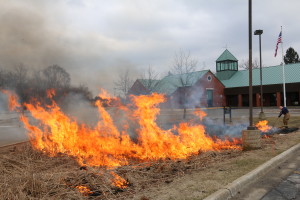By Susan Bromley
Staff Writer
Brandon Twp.
– There was a bonfire of sorts at the library on Wednesday.
A controlled burn of phragmites was conducted by the Brandon Fire Department, authorized by township and library officials. Phragmites are an invasive species and the library was a demonstration site for their management.
“The phragmites were treated last year and it’s important to knock them down when they are treated, so any new growth or any areas missed can be easily identified and treated,” said Township Supervisor Kathy Thurman.
“They were cut down first. This burn was for dead phragmites and should only be done by professionals. Once they are knocked down, any plants that were missed by treatment the first year can easily be treated the second year.”
The township is part of the Oakland County Cooperative Invasive Species Management Area (OCCISMA) since 2014 and as such, has received grant funding from the state to treat invasive species including phragmites and swallow wort. Last year, the township received $14,593 in grant funding, which was used for treating 6.5 acres of phragmites and 4.5 acres of swallow wort on both private and public properties. Phragmites, which have an extensive root system, crowd out cattails and other native plants and cause harm to wildlife habitat. They can also become a fire hazard and reduce property values.
In 2015, herbicide was sprayed by Natural Community Services with the intent to kill phragmites in 300 locations in the township, including various easements along Allen, Oakhill, Perry Lake, Bald Eagle Lake, Reese, Marsh, Granger, Hadley, Honert, Sands, Hummer Lake, Oakwood, Poli, Lockwood, Herd, Baldwin, Sashabaw, Dartmouth, Ramsey, Wooley, Sherwood, Persimmons and Saw Mill Lake roads.
Phragmites are found throughout North America. Although there is a native variety of the plant along the Atlantic seaboard, non-native phragmites first appeared in coastal ports in the eastern U.S. in the early 19th century, according to the U.S. Fish and Wildlife Service (www.fws.gov). The plant’s rapid spread in the 20th century is attributed to the construction of railroads and major roadways, habitat disturbance, shoreline development and pollution.
Phragmites are highly flammable and reach heights of nearly 20 feet when fully grown. If they catch on fire as they did in 2012 near Great Lakes Crossing Mall, shutting down I-75 and forcing the evacuation of homes and businesses, the flames can reach up to 75-feet tall, said John DeLisle, owner of NCS, who adds that the habitat value for wildlife goes to zero when an area is covered by phragmites, as nothing eats it or uses it for shelter.
For more information on phragmites control, visit http://naturalcommunityservices.webs.com/ or www.oaklandphragmitestaskforce.com.
